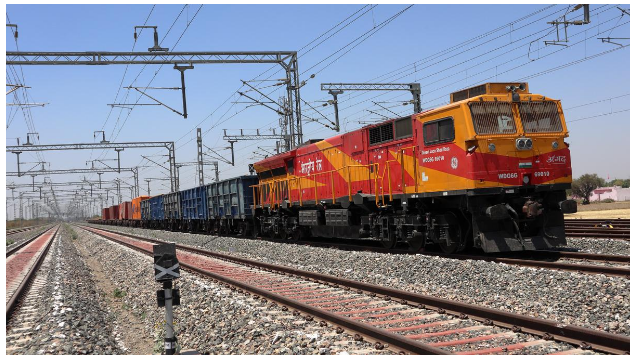Context:
The article analyses how the railways offer an efficient and economic mode of logistics movement given their panIndia network.
- It suggests that the increased adoption of the railways for cargo movement is crucial to improve the country’s logistics competitiveness.

Image Source: The Hindu
| Probable Question:
Q. To improve the logistics efficiency of India, Railways can be a game changer. To what extent can railways play such a transformative role? Also enumerate the steps taken by the government in this regard. |
About PM Gati Shakti:
- PM Gati Shakti provides the right platform to address the infrastructural challenges that have hampered the movement of freight by rail.
- It has a target of increasing the share of the railways in freight movement from 27% to 45% and increasing freight movement from 1.2 billion tonnes to 3.3 billion tonnes, by 2030.
- The Union Budget 2023 has doubled the PM Gati Shakti National Master Plan to States from ₹5,000 crore to ₹10,000 crore, and has announced an outlay of ₹2.4 lakh crore for the Indian Railways.
Challenges faced by Indian Railways:
- Operational and connectivity issues: There are infrastructural, operational and connectivity challenges, in turn leading to a shift of freight traffic to roads.
- Increased transit time: The increased transit time by rail and pre-movement and post-movement procedural delays such as wagon placement, loading and unloading operations, multimodal handling, etc., hamper freight movement by rail.
- Infrastructural issue: The lack of necessary terminal infrastructure, maintenance of good sheds and warehouses, and uncertain supply of wagons are some of the infrastructural challenges that customers face.
- Absence of integrated first and last mile connectivity:This results in high network congestion, lower service levels, and increased transit time. The absence of integrated first and last mile connectivity by rail increases the chances of damage due to multiple handling.
- Transportation of non bulk commodities:The transportation of non bulk commodities accounts for a very small share in the rail freight movement. In 2020-21, coal constituted 44% of the total freight movement of 1.2 billion tonnes, followed by iron ore (13%), cement (10%), food grains (5%).
- Lacks Modernisation: Indian Railways has not been able to keep pace with modernisation of infrastructure and services. Almost all arms of the railways require modernisation of equipment, processes and training.
- Accidents: In India rail accidents are high. In 2018-19, railways recorded 16 deaths, 28 deaths in 2017-2018 and 195 deaths during 2016-2017.
Steps have been taken by the Government for enhancing railway connectivity:
- Dedicated Freight Corridors (DFCs): The DFCs are being created with the motive of improving the share of freight traffic.
- DFCs include:
- The Western Dedicated Freight Corridor (WDFC), from Uttar Pradesh to Mumbai;
- The Eastern Dedicated Freight Corridor (EDFC), Ludhiana in Punjab to Dankuni in West Bengal.
- Atma Nirbhar Bharat Initiative: After this, more than 97% of the equipment required for the production of electric locomotives is being sourced domestically.
- Green Fuel Initiatives: Indian Railways is aiming to achieve 100 percent electrification of railway lines by December 2023.
- Station Infrastructure Redevelopment Programme: The Government of India has launched the station redevelopment programme, which aims to redevelop 400 railway stations across India for INR 1,000 billion under a public-private partnership (PPP) model.
What should be done?
- Setting up of a Special entity: Establishing a special entity under the railways to handle intermodal logistics in partnership with the private sector can help in addressing the first and last mile issue faced by the railways.
- Following Global Practice: India should follow the global practice of heavily investing in advanced rail infrastructure for quick and low cost container movement.
- For example, China uses special trains to carry containers that connect significant ports to the inland, and has dedicated rail lines to move container traffic and planned double-decker container carriages for greater efficiency.
- Creation of a statutory railway safety authority:The Kakodkar committee had suggested investing INR 1 lakh crore over a 5-year period and the creation of a statutory railway safety authority.
Conclusion:
- An integrated logistics infrastructure with first and last mile connectivity is essential to make rail movement competitive with roads, and facilitate exports by rail to neighbouring countries such as Nepal and Bangladesh.
- The upcoming Dedicated Freight Corridors along India’s eastern and western corridors and multimodal logistics parks will ease the oversaturated line capacity constraints and improve the timing of trains.
News Source: The Hindu
![]() 10 Mar 2023
10 Mar 2023
